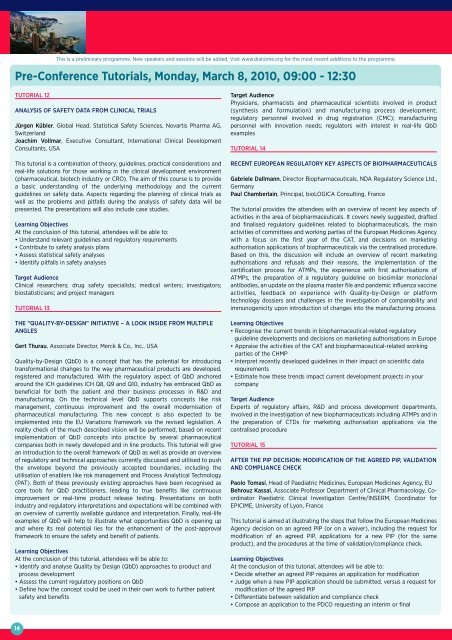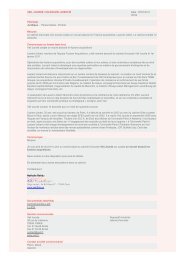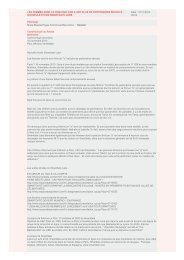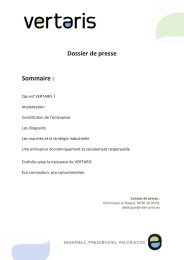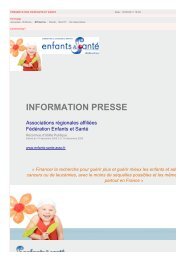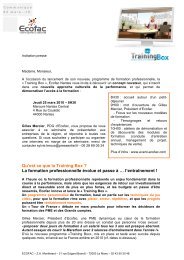Pre-Conference Tutorials, Monday, March 8, 2010, 09:00
Pre-Conference Tutorials, Monday, March 8, 2010, 09:00
Pre-Conference Tutorials, Monday, March 8, 2010, 09:00
You also want an ePaper? Increase the reach of your titles
YUMPU automatically turns print PDFs into web optimized ePapers that Google loves.
14<br />
This is a preliminary programme. New speakers and sessions will be added. Visit www.diahome.org for the most recent additions to the programme.<br />
<strong>Pre</strong>-<strong>Conference</strong> <strong>Tutorials</strong>, <strong>Monday</strong>, <strong>March</strong> 8, <strong>2010</strong>, <strong>09</strong>:<strong>00</strong> - 12:30<br />
TUTORIAL 12<br />
ANALYSIS OF SAFETY DATA FROM CLINICAL TRIALS<br />
Jürgen Kübler, Global Head, Statistical Safety Sciences, Novartis Pharma AG,<br />
Switzerland<br />
Joachim Vollmar, Executive Consultant, International Clinical Development<br />
Consultants, USA<br />
This tutorial is a combination of theory, guidelines, practical considerations and<br />
real-life solutions for those working in the clinical development environment<br />
(pharmaceutical, biotech industry or CRO). The aim of this course is to provide<br />
a basic understanding of the underlying methodology and the current<br />
guidelines on safety data. Aspects regarding the planning of clinical trials as<br />
well as the problems and pitfalls during the analysis of safety data will be<br />
presented. The presentations will also include case studies.<br />
Learning Objectives<br />
At the conclusion of this tutorial, attendees will be able to:<br />
• Understand relevant guidelines and regulatory requirements<br />
• Contribute to safety analysis plans<br />
• Assess statistical safety analyses<br />
• Identify pitfalls in safety analyses<br />
Target Audience<br />
Clinical researchers; drug safety specialists; medical writers; investigators;<br />
biostatisticians; and project managers<br />
TUTORIAL 13<br />
THE "QUALITY-BY-DESIGN" INITIATIVE – A LOOK INSIDE FROM MULTIPLE<br />
ANGLES<br />
Gert Thurau, Associate Director, Merck & Co., Inc., USA<br />
Quality-by-Design (QbD) is a concept that has the potential for introducing<br />
transformational changes to the way pharmaceutical products are developed,<br />
registered and manufactured. With the regulatory aspect of QbD anchored<br />
around the ICH guidelines ICH Q8, Q9 and Q10, industry has embraced QbD as<br />
beneficial for both the patient and their business processes in R&D and<br />
manufacturing. On the technical level QbD supports concepts like risk<br />
management, continuous improvement and the overall modernisation of<br />
pharmaceutical manufacturing. This new concept is also expected to be<br />
implemented into the EU Variations framework via the revised legislation. A<br />
reality check of the much described vision will be performed, based on recent<br />
implementation of QbD concepts into practice by several pharmaceutical<br />
companies both in newly developed and in line products. This tutorial will give<br />
an introduction to the overall framework of QbD as well as provide an overview<br />
of regulatory and technical approaches currently discussed and utilised to push<br />
the envelope beyond the previously accepted boundaries, including the<br />
utilisation of enablers like risk management and Process Analytical Technology<br />
(PAT). Both of these previously existing approaches have been recognised as<br />
core tools for QbD practitioners, leading to true benefits like continuous<br />
improvement or real-time product release testing. <strong>Pre</strong>sentations on both<br />
industry and regulatory interpretations and expectations will be combined with<br />
an overview of currently available guidance and interpretation. Finally, real-life<br />
examples of QbD will help to illustrate what opportunities QbD is opening up<br />
and where its real potential lies for the enhancement of the post-approval<br />
framework to ensure the safety and benefit of patients.<br />
Learning Objectives<br />
At the conclusion of this tutorial, attendees will be able to:<br />
• Identify and analyse Quality by Design (QbD) approaches to product and<br />
process development<br />
• Assess the current regulatory positions on QbD<br />
• Define how the concept could be used in their own work to further patient<br />
safety and benefits<br />
Target Audience<br />
Physicians, pharmacists and pharmaceutical scientists involved in product<br />
(synthesis and formulation) and manufacturing process development;<br />
regulatory personnel involved in drug registration (CMC); manufacturing<br />
personnel with innovation needs; regulators with interest in real-life QbD<br />
examples<br />
TUTORIAL 14<br />
RECENT EUROPEAN REGULATORY KEY ASPECTS OF BIOPHARMACEUTICALS<br />
Gabriele Dallmann, Director Biopharmaceuticals, NDA Regulatory Science Ltd.,<br />
Germany<br />
Paul Chamberlain, Principal, bioLOGICA Consulting, France<br />
The tutorial provides the attendees with an overview of recent key aspects of<br />
activities in the area of biopharmaceuticals. It covers newly suggested, drafted<br />
and finalised regulatory guidelines related to biopharmaceuticals, the main<br />
activities of committees and working parties of the European Medicines Agency<br />
with a focus on the first year of the CAT, and decisions on marketing<br />
authorisation applications of biopharmaceuticals via the centralised procedure.<br />
Based on this, the discussion will include an overview of recent marketing<br />
authorisations and refusals and their reasons, the implementation of the<br />
certification process for ATMPs, the experience with first authorisations of<br />
ATMPs, the preparation of a regulatory guideline on biosimilar monoclonal<br />
antibodies, an update on the plasma master file and pandemic influenza vaccine<br />
activities, feedback on experience with Quality-by-Design or platform<br />
technology dossiers and challenges in the investigation of comparability and<br />
immunogenicity upon introduction of changes into the manufacturing process.<br />
Learning Objectives<br />
• Recognise the current trends in biopharmaceutical-related regulatory<br />
guideline developments and decisions on marketing authorisations in Europe<br />
• Appraise the activities of the CAT and biopharmaceutical-related working<br />
parties of the CHMP<br />
• Interpret recently developed guidelines in their impact on scientific data<br />
requirements<br />
• Estimate how these trends impact current development projects in your<br />
company<br />
Target Audience<br />
Experts of regulatory affairs, R&D and process development departments,<br />
involved in the investigation of new biopharmaceuticals including ATMPs and in<br />
the preparation of CTDs for marketing authorisation applications via the<br />
centralised procedure<br />
TUTORIAL 15<br />
AFTER THE PIP DECISION: MODIFICATION OF THE AGREED PIP, VALIDATION<br />
AND COMPLIANCE CHECK<br />
Paolo Tomasi, Head of Paediatric Medicines, European Medicines Agency, EU<br />
Behrouz Kassai, Associate Professor Department of Clinical Pharmacology, Coordinator<br />
Paediatric Clinical Investigation Centre/INSERM, Coordinator for<br />
EPICIME, University of Lyon, France<br />
This tutorial is aimed at illustrating the steps that follow the European Medicines<br />
Agency decision on an agreed PIP (or on a waiver), including the request for<br />
modification of an agreed PIP, applications for a new PIP (for the same<br />
product), and the procedures at the time of validation/compliance check.<br />
Learning Objectives<br />
At the conclusion of this tutorial, attendees will be able to:<br />
• Decide whether an agreed PIP requires an application for modification<br />
• Judge when a new PIP application should be submitted, versus a request for<br />
modification of the agreed PIP<br />
• Differentiate between validation and compliance check<br />
• Compose an application to the PDCO requesting an interim or final


